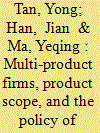| Srl | Item |
| 1 |
ID:
071992


|
|
|
|
|
| Publication |
2006.
|
| Summary/Abstract |
This paper develops a Cournot quantity competition model to examine the effect of export tax rebate policy on export performance. The main conclusions drawn are as follows: (i) when a government raises the export rebate rate, the output of final goods for export by the domestic firm increases, while the output of the foreign competitor decreases; (ii) when a government raises the export rebate rate, the profit of the domestic firm increases, while that of the foreign competitor decreases; and (iii) the optimum export rebate rate is positive and greater than 1, indicating that the domestic government not only refunds fully the custom duties paid by the domestic firm on imported intermediate goods, but also offers export subsidies for its export of final goods.
To corroborate the conclusions drawn based on the theoretical model, empirical analysis was carried out using the statistical data of China from 1985 to 2002. The test results of Spearman rank correlation coefficient show that China's export tax rebate policy has significant positive correlation with its exports, final domestic consumption, and foreign exchange reserve.
|
|
|
|
|
|
|
|
|
|
|
|
|
|
|
|
| 2 |
ID:
143387


|
|
|
|
|
| Summary/Abstract |
This paper extends the model of Nocke and Yeaple (2014) to analyze the impact of the export tax rebate (ETR) changes on multi-product firms' product scope. In response to ETR changes, firms optimally reallocate their organizational capital, and adjust the intensive and extensive margins of production. We test the model's predictions using firm-level export and ETR data from China. We find that less profitable products, facing larger ETR reductions, and products in which China has a comparative disadvantage, are more likely to be dropped.
|
|
|
|
|
|
|
|
|
|
|
|
|
|
|
|